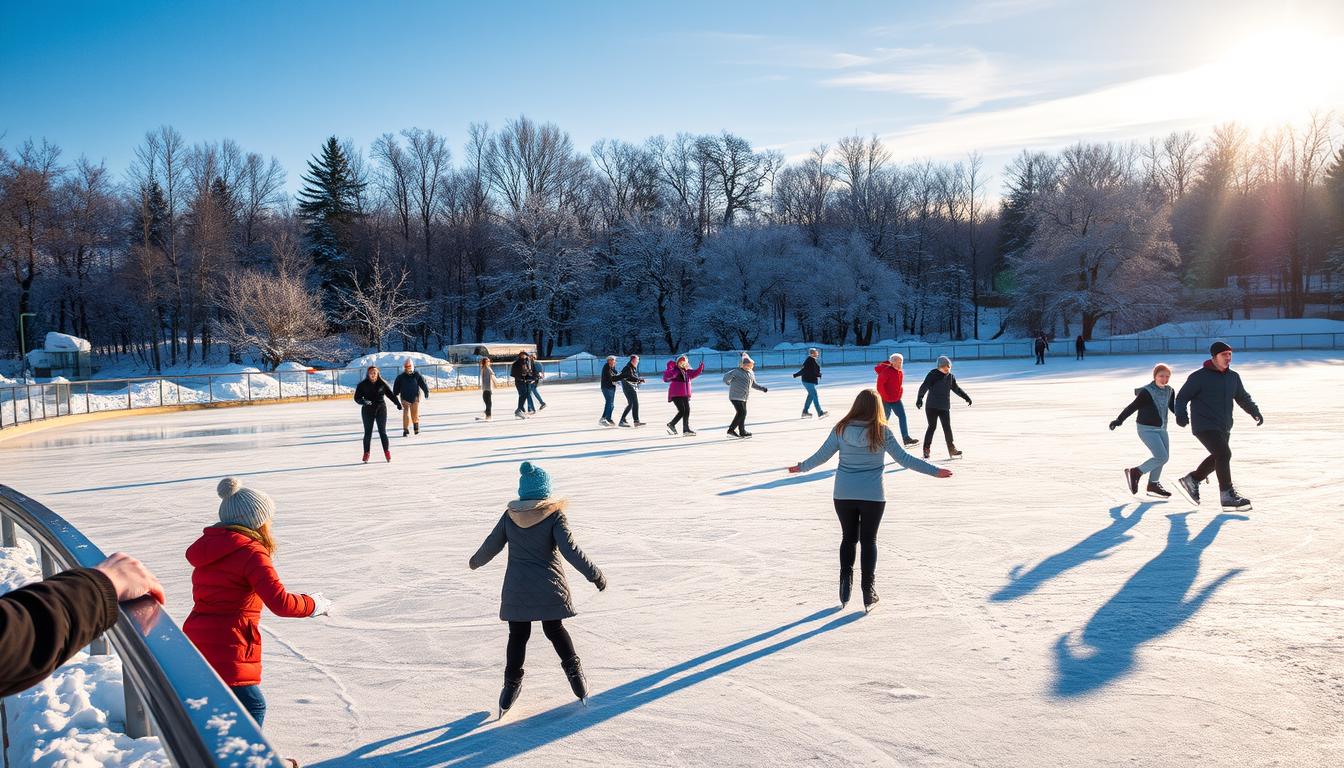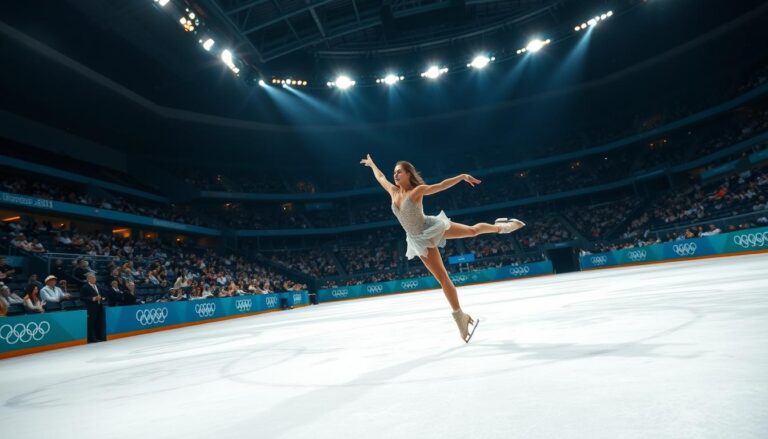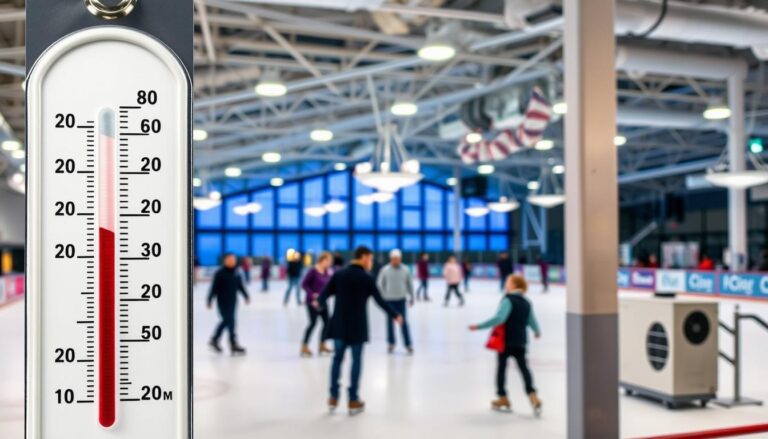Ice Skating 101: A Beginner’s Guide to the Sport
Imagine the cold winter air and the smooth sound of blades on ice. Ice skating is more than a sport; it’s an art that combines grace and joy. Whether you dream of elegant moves or just want to have fun, learning about ice skating can be exciting.
This guide will change how you see ice skating. It’s not just for pros; it’s for anyone who wants to have fun or get fit. Ice skating is versatile and great for a full-body workout.
Starting out, you might feel nervous. But remember, every pro was once a beginner. The key is to be patient, learn the right techniques, and stay positive. You’ll learn to balance, gain confidence, and feel like you’re flying.
Ice skating is more than just skills. It’s a full-body and mind experience. You’ll get stronger, improve balance, and boost your heart and mind. Every step is a victory, connecting you with the joy of movement.
In this guide, we’ll cover everything for beginners. You’ll learn basic techniques, choose the right gear, explore different styles, and stay safe. You’ll be ready to start your ice skating adventure with confidence.
So, get your skates ready and start your ice skating journey. It’s time to learn, grow, and enjoy every moment on the ice.
What Is Ice Skating: Understanding the Basics
Ice skating is a fun winter sport that turns ice into a place for movement and skill. It’s about gliding on ice using special boots with metal blades. This mix of art, athleticism, and grace makes it special.
Learning ice skating techniques means diving into its many sides. Skaters can see it from different angles, each with its own challenges and joys.
Recreational vs Competitive Skating
Ice skating offers two main ways to enjoy it:
- Recreational Skating: A fun, laid-back way to stay active and enjoy the ice
- Competitive Skating: A serious path focused on mastering skills and performing well
Different Types of Ice Skating Disciplines
Ice skating has many exciting areas to explore:
- Figure Skating: It’s all about artistic movements and beautiful choreography
- Speed Skating: It’s about racing fast on long tracks
- Ice Dancing: It’s a synchronized dance for two
- Hockey Skating: It’s all about quick movements in ice hockey
Core Skating Movements
Learning ice skating starts with basic moves:
- Getting your balance right and distributing your weight
- Gliding forward and backward
- Stopping and turning
- Controlling your edges and keeping your body aligned
Whether you’re just starting or aiming to be a pro, knowing these basics is key. Each move takes practice, patience, and a readiness to face the ice’s unique challenges.
The Rich History of Ice Skating Through the Ages
Ice skating has a long history, showing how humans have always been inventive. Long ago, people found ways to move on ice, turning it into a fun sport.
The first ice skates were made from animal bones around 3000 BCE in Finland and Scandinavia. These early skates helped people move on frozen lakes and rivers. They were a clever way to get around in winter.
- 3000 BCE: First bone skates in Scandinavia
- 1250 CE: Metal blades introduced in Netherlands
- 1600s: Ice skating becomes a popular winter activity in Europe
In the Victorian era, ice skating became more than just a way to get around. It became a fancy sport that Europeans loved. They developed fancy moves and started the modern figure skating we know today.
The 19th century brought big changes to ice skating. The first artificial ice rink opened in London in 1876. This made skating more accessible to everyone, not just the rich.
People like Jackson Haines, an American figure skater, added art to skating. His moves were like dance, changing how we watch figure skating today.
- 1870s: Jackson Haines introduces artistic skating techniques
- 1908: First Winter Olympics featuring skating competitions
- 1924: International Skating Union establishes global standards
Ice skating has come a long way from being just a way to get around. It’s now a global sport that shows our creativity and love for movement.
Essential Ice Skating Equipment for Beginners
Stepping onto the ice is more than just courage. It also needs the right equipment. Whether you’re new to skating or want to get better, the right gear makes a big difference.
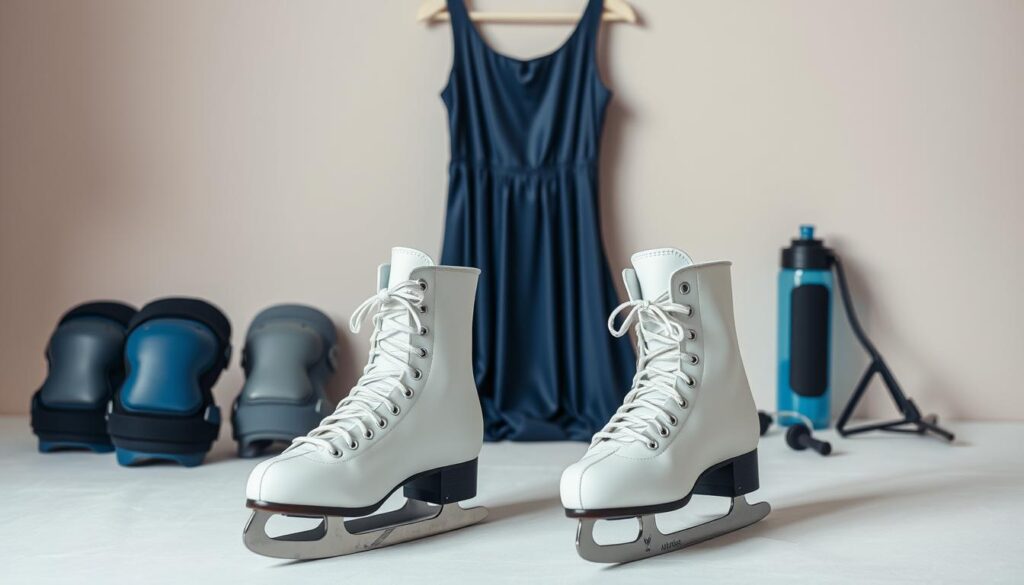
Getting ready for ice skating means picking the right gear. This ensures you’re comfortable, safe, and perform well. Let’s look at the essential gear every beginner needs.
Choosing Your First Pair of Skates
Finding the perfect skates is key for your skating journey. Think about these important factors when picking your first skates:
- Proper fit is key – skates should be snug but not too tight
- Think about your skating goals (recreational or competitive)
- Look for good ankle support
- Decide between figure skates or hockey skates based on your style
Protective Gear Requirements
Safety is first when learning to skate. The right protective gear prevents injuries and boosts confidence.
| Protective Gear | Purpose | Recommended for Beginners |
|---|---|---|
| Helmet | Head protection | Absolutely essential |
| Knee Pads | Protect knees during falls | Highly recommended |
| Wrist Guards | Prevent wrist injuries | Strongly suggested |
| Padded Shorts | Hip and tailbone protection | Optional but beneficial |
Proper Skating Attire
Your clothes can affect your comfort and performance. Dress in layers that allow maximum movement:
- Wear form-fitting, stretchy pants or leggings
- Choose a moisture-wicking base layer
- Select a light jacket or sweater for warmth
- Wear thin, warm socks (avoid thick, bulky options)
Investing in quality ice skating equipment might seem overwhelming. But it’s the first step to enjoying skating. Start with the basics and ask for advice from experienced skaters or rink staff.
Finding the Right Ice Skating Rink Near You
Discovering the perfect ice skating rinks can make your skating journey exciting. Your local rink is more than just a frozen surface. It’s your gateway to mastering this incredible sport.
When searching for ice skating rinks, consider these key factors:
- Location and accessibility
- Public skating schedules
- Equipment rental options
- Lesson availability
- Skill level accommodations
Different types of ice skating rinks offer unique experiences. Indoor facilities provide consistent conditions year-round. On the other hand, outdoor seasonal rinks deliver a classic winter atmosphere. Urban areas typically feature multiple options, giving skaters flexibility in choosing their ideal skating environment.
Pro skaters recommend checking local community centers, parks and recreation departments, and dedicated ice skating complexes. Many facilities offer beginner-friendly sessions with supportive staff ready to help newcomers feel comfortable.
Budget-conscious skaters can take advantage of:
- First-time visitor discounts
- Group rate packages
- Weekday morning skating sessions
- Community center memberships
Research is key. Call ahead, visit websites, and read reviews to find ice skating rinks that match your skill level and learning goals. Your perfect skating home is waiting to be discovered!
Fundamental Ice Skating Techniques for Beginners
Stepping onto the ice for the first time can feel intimidating. But mastering basic ice skating techniques boosts your confidence and enjoyment. This guide breaks down essential skills for ice skating for beginners, helping you glide with grace and control.
Learning ice skating techniques requires patience and practice. New skaters should focus on developing core skills. These skills build a strong foundation for more advanced movements.
Basic Skating Stance
Your skating stance is the cornerstone of all ice skating techniques. Follow these key positioning tips:
- Keep knees slightly bent for better balance
- Maintain a straight back with shoulders relaxed
- Distribute weight evenly between both feet
- Look forward, not down at your skates
Forward and Backward Gliding
Mastering forward and backward gliding is key for beginners. Start with small, controlled movements:
- Push off gently with one foot
- Shift weight smoothly to gliding foot
- Keep core engaged for stability
- Practice alternating feet for consistent motion
Stopping Methods
Safe stopping is an essential skill for all ice skaters. Two fundamental techniques include:
- Snowplow Stop: Turn feet inward, push heels out to create a wedge shape
- T-Stop: Drag one foot perpendicular behind the other to slow down
Remember, developing ice skating techniques takes time. Stay patient, practice regularly, and enjoy the learning process.
Safety Measures and Precautions on Ice

Ice skating safety tips are key to having fun on the rink without risks. Whether you’re new or experienced, knowing safety tips can prevent injuries. It also makes skating more enjoyable.
Wearing protective gear is important for ice skating safety. Skaters should always wear:
- Properly fitted helmet
- Wrist guards
- Knee and elbow pads
- Thick, warm clothing that allows movement
Learning how to fall correctly is a must for ice skating safety. Falling correctly can dramatically reduce your risk of serious injury. Practice these techniques:
- Bend your knees when losing balance
- Try to fall sideways, not forward or backward
- Keep your arms close to your body
- Avoid using hands to break a fall
Being aware of your surroundings is key on the ice. Watch out for other skaters, keep a safe distance, and follow rink rules. Beginners should stay in less crowded areas and practice near the rink’s edge until they feel more confident.
Before hitting the ice, always check your gear. Make sure your skates are sharp, blades are secure, and laces are tight. Worn-out or poorly maintained skates can lead to accidents.
Proper Warm-up Exercises for Ice Skating
Getting ready for ice skating is more than just getting on the ice. Doing the right warm-up exercises is key to avoiding injuries and getting better at skating. A good warm-up can make your skating much better.
Skaters know that a good warm-up is essential for doing well. Your body needs to be ready for the special challenges of moving on ice.
Off-Ice Training Tips
Building strength and flexibility off the ice can really help your skating. Here are some tips for training:
- Balance board exercises to improve core stability
- Plyometric jumps for leg strength
- Resistance band workouts targeting skating muscle groups
- Yoga sequences for overall flexibility
Stretching Routines
Dynamic stretching is important for getting your muscles ready for skating. Focus on stretches that are like skating movements:
- Leg swings (forward and side)
- Lunges with rotation
- Ankle mobility exercises
- Hip flexor stretches
Pro tip: Always start with light cardio to increase blood flow before stretching. This helps prevent muscle strain and prepares your body for more intense skating movements.
By using these warm-up and training tips, you’ll lay a strong foundation for mastering ice skating. You’ll also lower your chance of getting hurt.
Common Mistakes Beginners Should Avoid
Ice skating for beginners can be tough. Knowing common mistakes helps you learn faster and feel more confident. Catching and fixing these errors early stops bad habits and lowers injury risks.
Starting out, many beginners make key mistakes. Here are the top ones:
- Looking Down at Your Feet: This messes up your balance and can lead to falls
- Incorrect Body Posture: You might lean too far forward or backward
- Stiff Leg Movements: This stops you from gliding smoothly
- Tensing Up: It puts too much strain on your muscles
Now, let’s look at these mistakes in detail, with tips for beginners:
| Mistake | Correction Strategy |
|---|---|
| Poor Balance | Keep knees slightly bent, weight centered |
| Incorrect Arm Position | Arms relaxed, slightly out for stability |
| Ankle Weakness | Strengthen ankle muscles through off-ice exercises |
Experts say to practice these fixes slowly. Don’t worry if it’s hard at first. Every pro started where you are now, learning and getting better with each try.
Pro tip: Think about getting lessons from a certified teacher. They can give you tailored advice and help you learn the right way from the start.
Physical and Mental Benefits of Ice Skating
Ice skating is more than just fun on the ice. It’s a full-body workout that boosts your health and well-being. This activity turns simple gliding into a powerful fitness journey.
Fitness Advantages of Ice Skating
Stepping onto the ice means working out your whole body at once. Ice skating benefits include:
- Burning up to 500-650 calories per hour
- Strengthening leg muscles, like quadriceps and calves
- Improving your heart health
- Boosting core stability and balance
The movements in ice skating are challenging yet low-impact. They help build strength and endurance in a unique way.
Psychological Benefits of Skating
Ice skating also has amazing mental health perks. The rhythmic motion and focus required create a meditative experience that reduces stress and boosts mental health.
- Reduces anxiety and depression symptoms
- Boosts self-confidence through skill mastery
- Provides social interaction opportunities
- Enhances cognitive function through complex motor skills
Ice skating benefits everyone, whether you’re new or experienced. It offers a holistic approach to personal health and wellness.
Understanding Figure Skating vs Recreational Ice Skating
Ice skating offers different experiences for fans. Figure skating and recreational ice skating are two main types. They have different goals, techniques, and skill levels.
Recreational ice skating is all about having fun and moving on the ice. People who do this:
- Skate for enjoyment and to stay fit
- Don’t need much technical training
- Wear standard rental skates
- Love skating with friends
Figure skating, on the other hand, is a high-level sport. Skaters spend a lot of time learning complex moves. They work on:
- Complicated footwork
- Perfecting jumps and spins
- Creating choreographed routines
- Following strict training plans
Olympic figure skaters train up to 6-8 hours a day. They need to be very skilled and also express themselves through their skating. It’s a mix of athleticism and art.
Recreational ice skating is great for everyone, no matter their age or skill. Figure skating, though, is for those who want to compete and need a lot of practice and talent.
Building Confidence on Ice: Progressive Learning Steps
Learning ice skating takes patience, practice, and a smart plan. As a beginner, you’re on a path to grow your confidence step by step. It’s all about understanding how your body moves and mastering the basics of skating.
First, focus on getting a good balance and control. Ice skating for beginners is about getting better slowly and having fun along the way.
Developing Balance on the Ice
Balance is key to being good at ice skating. Here are some important tips to start with:
- Practice standing steady on the ice with your feet apart
- Hold onto the wall while moving your weight from one foot to another
- Keep a slight bend in your knees for better balance
Enhancing Edge Control
Controlling your edges is important for better skating. Beginners can improve this by doing specific exercises:
- Practice gliding on both inside and outside edges
- Learn to move your weight from one foot to another
- Start with simple glides on one foot to get better control
Remember, every pro skater began where you are now. Being consistent and staying positive will help you become a confident skater.
As you get better, you’ll see your balance improve and your movements become smoother. Take your time, enjoy the learning, and celebrate every small win on the ice.
Maintaining and Caring for Your Skating Equipment
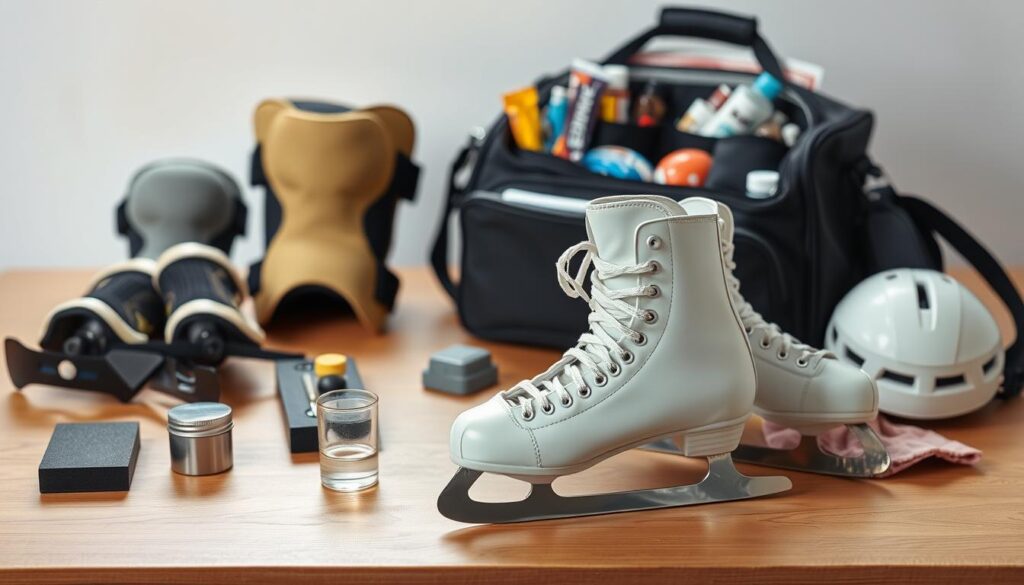
Keeping your ice skating equipment in good shape is key. It helps your gear last longer and perform better. Your skates are a big investment, and with the right care, they’ll be with you for many skating adventures.
Blade care is the most important part of keeping your equipment in top shape. Moisture is your biggest enemy, so always dry your blades well after skating. Skaters suggest using blade soakers to soak up extra moisture and stop rust.
- Clean blades right after skating
- Use a soft cloth to dry them
- Keep skates in a dry, cool spot
- Use guards to protect the blades
Don’t forget about boot care. Leather and synthetic materials need regular cleaning and conditioning to avoid cracking. Check your boots often for wear, focusing on the ankle and sole.
| Equipment Part | Maintenance Frequency | Key Care Tips |
|---|---|---|
| Blades | After each use | Dry thoroughly, use soakers |
| Boots | Weekly | Clean, condition leather |
| Laces | Monthly | Replace when frayed |
Get your blades sharpened every 20-40 hours of skating. This depends on your skill and how often you skate. Look for a specialized skating shop with skilled technicians who know what ice skating equipment needs.
Putting time into equipment care saves money and makes skating safer and more fun.
Advanced Techniques to Practice After Mastering Basics
Once you’ve mastered the basics, it’s time to try more challenging skills. These will make your skating better. You’ll need to practice a lot and learn new ways to move.
As you get better, learning advanced techniques is exciting. These skills turn your skating into art.
Basic Jumps: Your Gateway to Advanced Skating
Learning jumps is all about control and knowing where you are. Start with these basic jumps:
- Waltz Jump: A single-rotation jump perfect for beginners
- Salchow: A classic jump named after its Swedish inventor
- Toe Loop: A jump initiated with the toe pick for additional height
Spin Techniques to Master
Spinning is key for advanced skating. You need balance, strong core, and the right body position for each spin:
| Spin Type | Difficulty Level | Key Technique |
|---|---|---|
| One-Foot Spin | Beginner | Maintain centered balance on single foot |
| Sit Spin | Intermediate | Lower body while spinning on one foot |
| Camel Spin | Advanced | Extend leg horizontally while spinning |
Footwork Patterns: Creating Fluid Movements
Advanced skating includes complex footwork. This connects different parts of your skating. Practice these patterns to get better:
- Crossovers: Crossing one foot over another while skating
- Choctaw turns: Changing edge and direction in a single movement
- Mohawk turns: Changing foot position without losing momentum
Remember, these advanced techniques need a pro’s help. Always skate with a qualified instructor to learn right and stay safe.
Ice Skating Etiquette and Rink Rules
Ice skating is more than just moving on ice. Knowing the rules makes it safe and fun for everyone. Good manners make your time on the ice better.
When you skate, you must respect others. The ice is a shared space with its own rules. Here are some tips to be a good and safe skater:
- Skate in the designated direction (usually counterclockwise)
- Always check behind and around you before turning
- Give way to skaters doing tricks
- Stay away from other skaters
- Avoid sudden stops or changes in direction
Staying safe on the ice is key. If you fall, move to the side to let others pass. Beginners should skate near the edges to give room to others.
Every ice rink has its own rules. Some common ones are:
- No eating or drinking on the ice
- Wear the right protective gear
- Listen to the staff
- Respect both practice and public skating times
Following these guidelines makes the ice a better place. Respect and awareness are your best friends on the ice.
Joining Ice Skating Communities and Classes
Starting your ice skating journey can be thrilling and a bit scary. Finding friends who skate can make your experience more fun and supportive. Ice skating rinks are not just places to skate. They are also a way to connect with a passionate community.
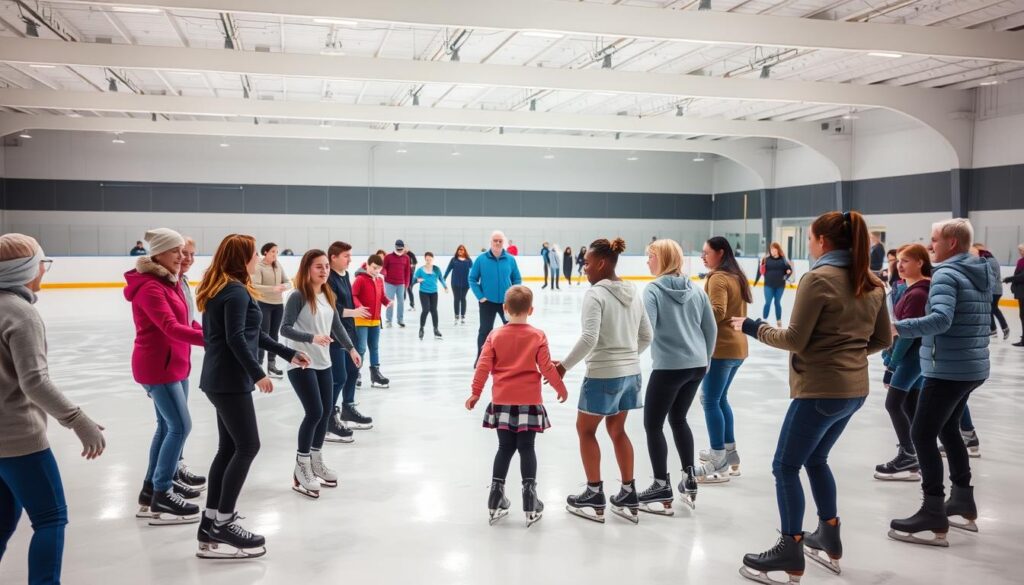
Finding the right skating group can help you learn faster and feel more confident. Here are some ways to get involved:
- Local Skating Clubs: Great for learning in a structured way and meeting others
- Group Classes: Provide professional lessons and a chance to meet people
- Online Communities: Let you connect with skaters all over the world
- Recreational Skating Groups: Perfect for having fun and practicing
There are different skating communities for different interests:
| Community Type | Focus | Best For |
|---|---|---|
| Recreational Clubs | Casual skating | Beginners and social skaters |
| Figure Skating Groups | Competitive training | Aspiring performers |
| Adult Skating Programs | Age-specific learning | Adults seeking skill development |
When looking for a community, think about your skill level and what you want to achieve. Many ice skating rinks have programs just for beginners. It’s okay to try out different groups until you find the right one.
Pro tip: Look for special events at local ice skating rinks. Events like themed skating nights or beginner workshops are great for meeting people, learning new things, and making friends in the skating world.
Conclusion
Ice skating for beginners is an exciting way to get fit, have fun, and grow. You’ve learned the basics in this guide. Now, you can start exploring the magical world of skating.
Ice skating does more than just entertain. It improves your core strength, balance, and mental health. Beginners find that skating boosts their confidence and fitness in ways other workouts can’t.
Keep practicing, being patient, and passionate as you skate. Every pro started where you are today. Enjoy learning, join local skating groups, and always try to get better.
Your ice skating journey is just beginning. Put on your skates, feel the cold, and enjoy every step. The ice is waiting for you, one glide at a time!
